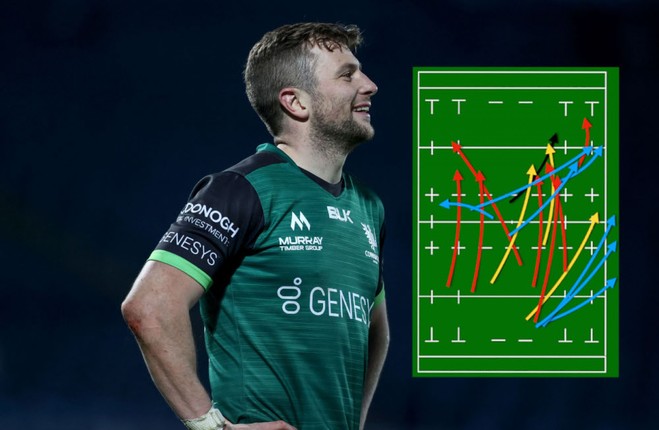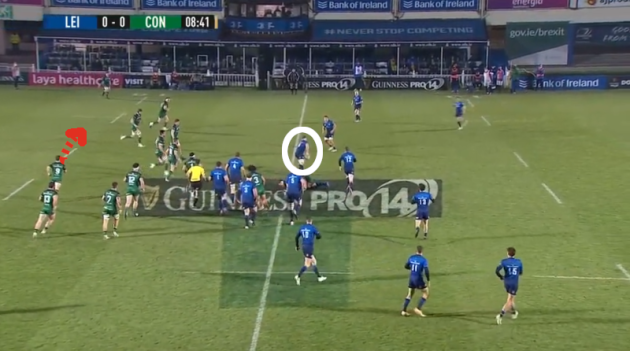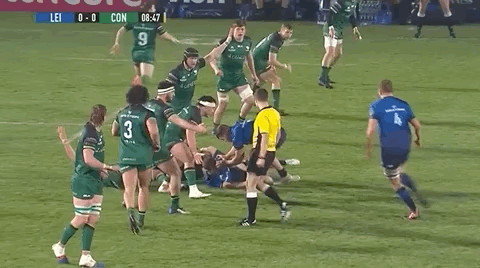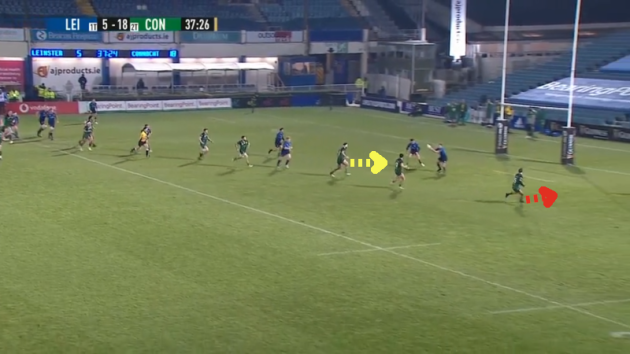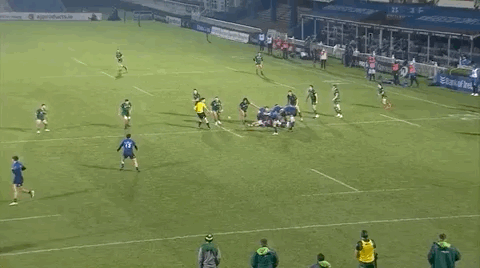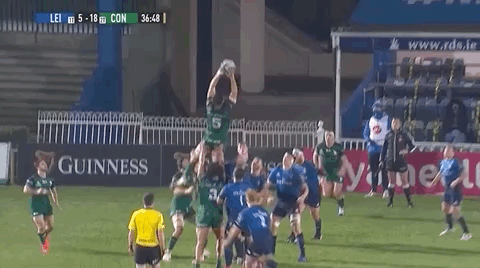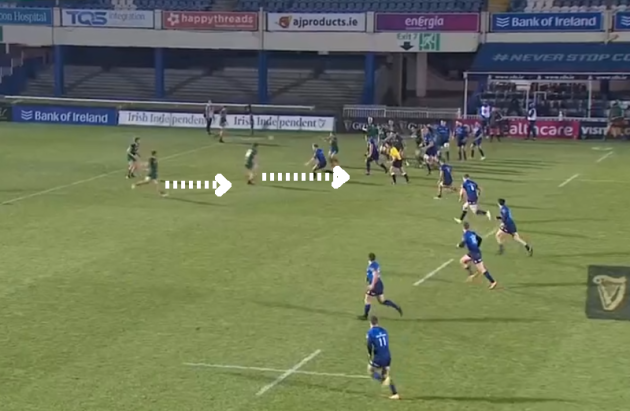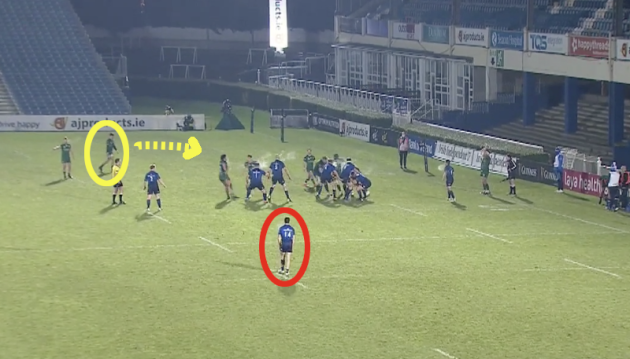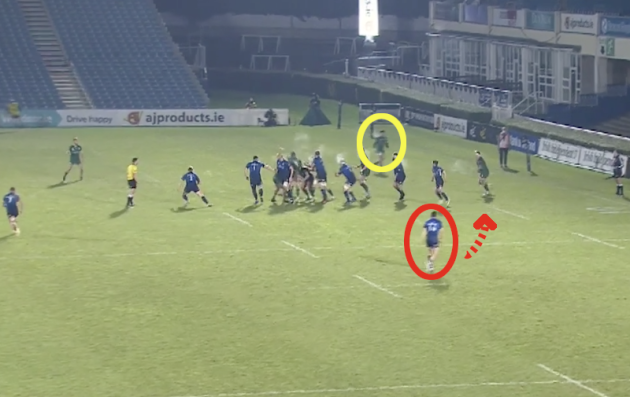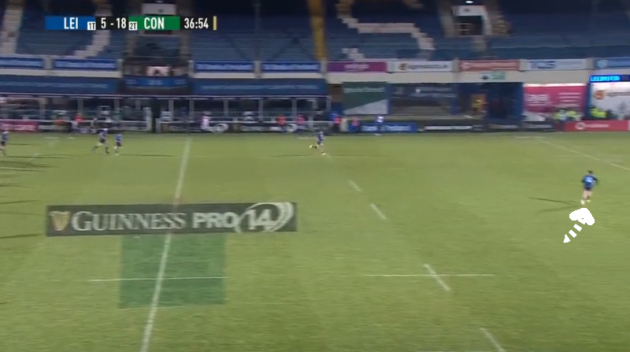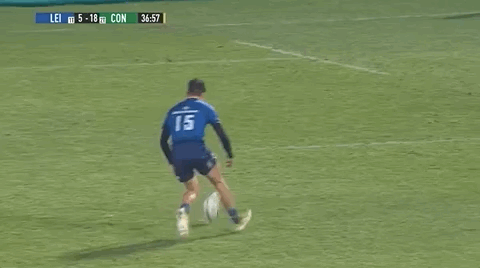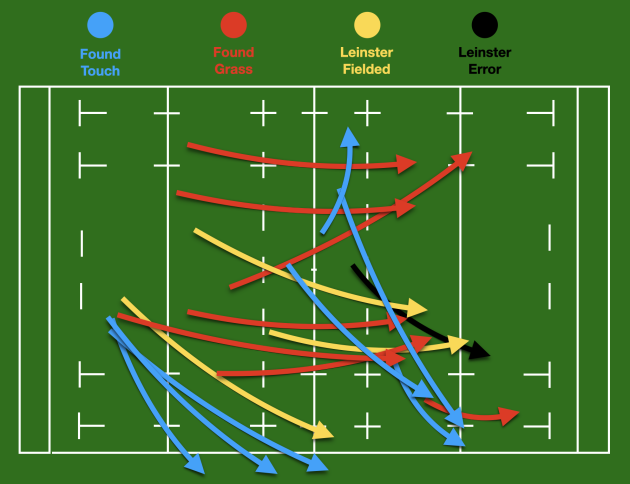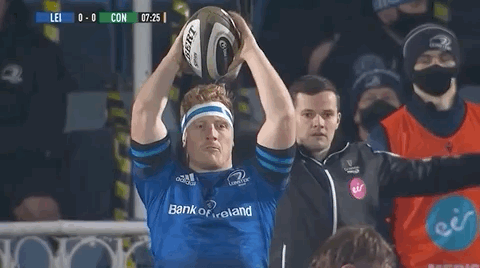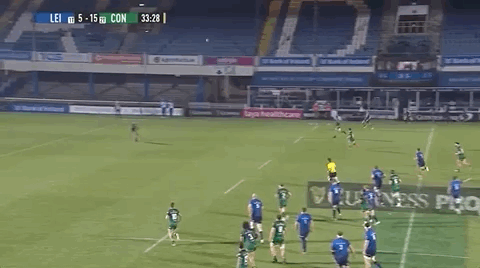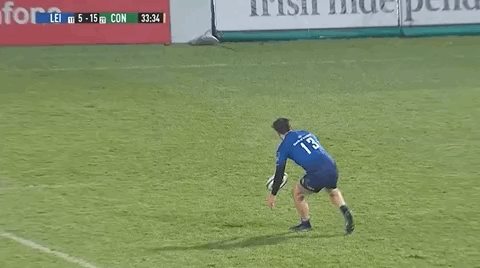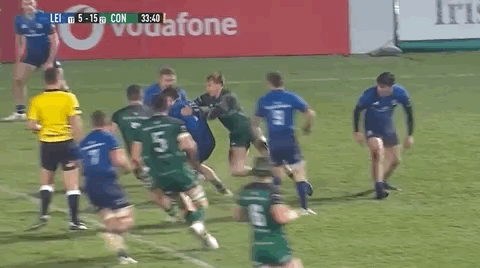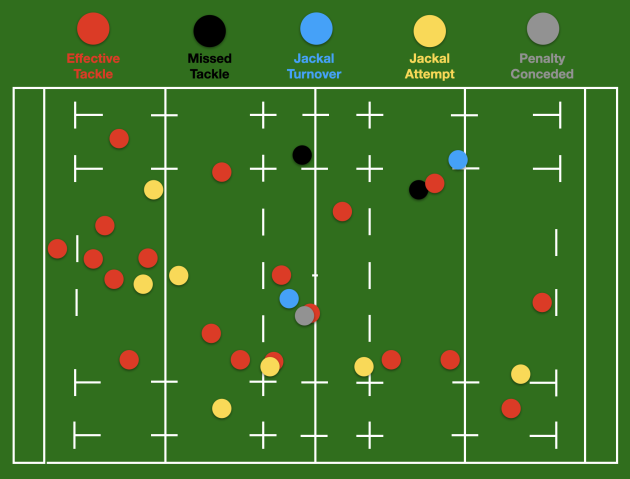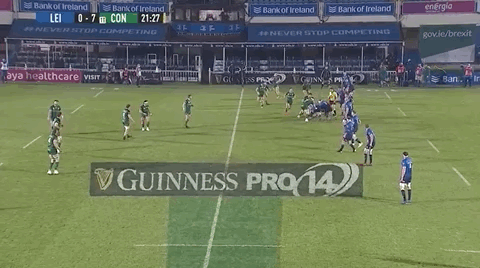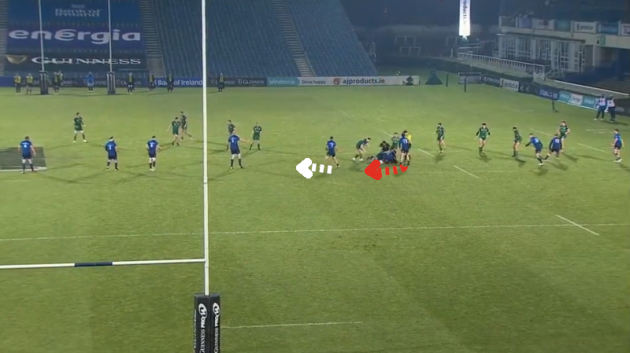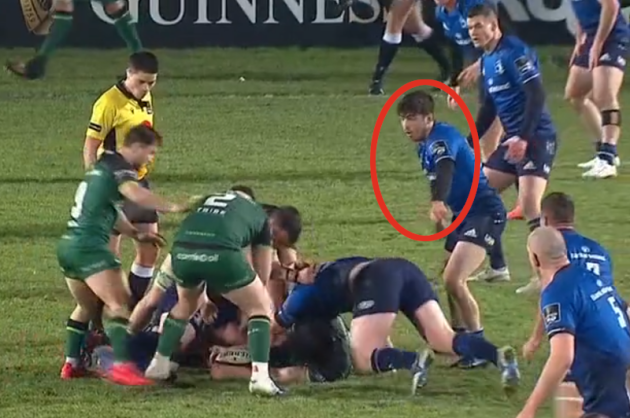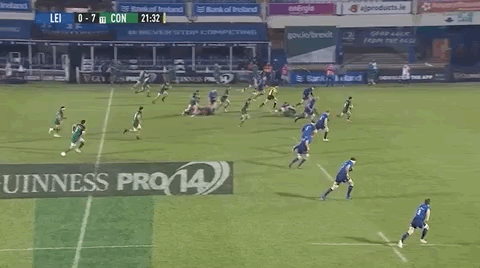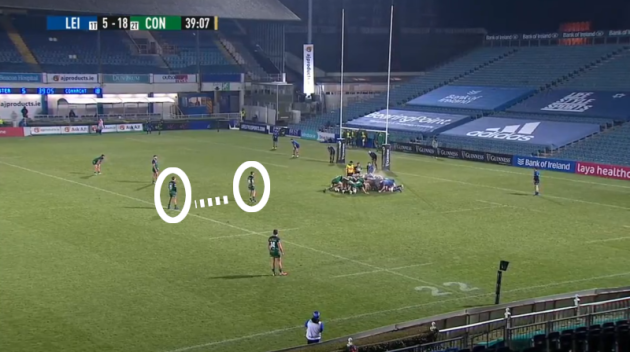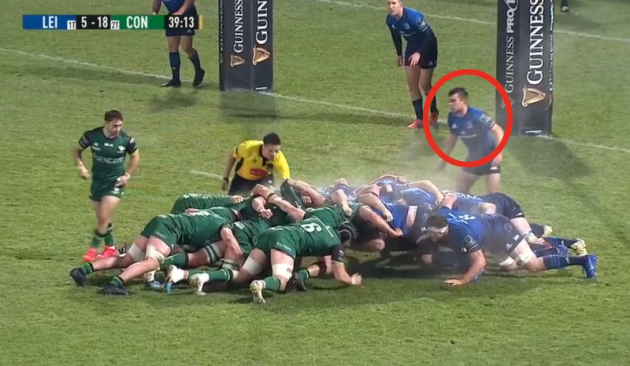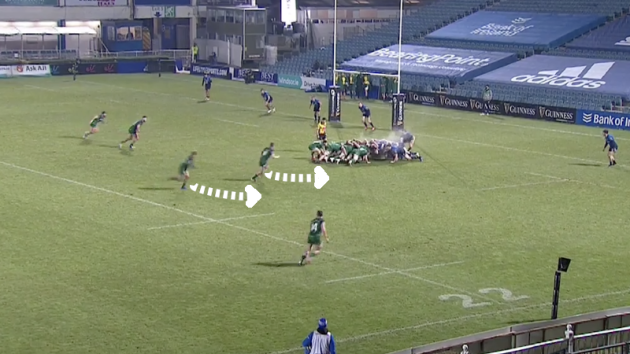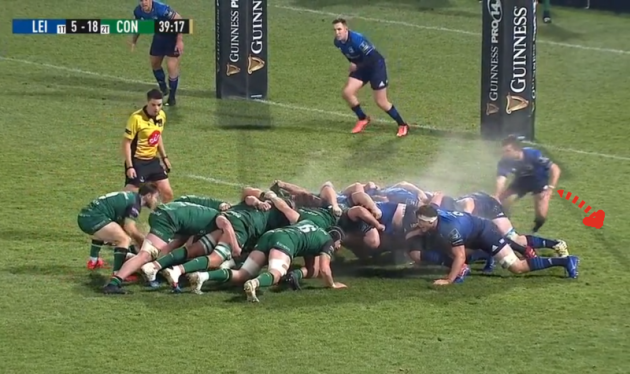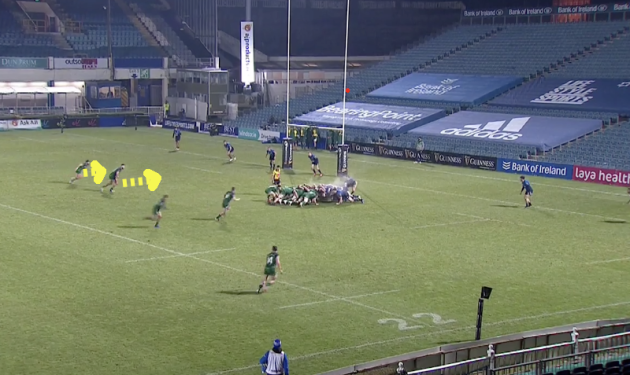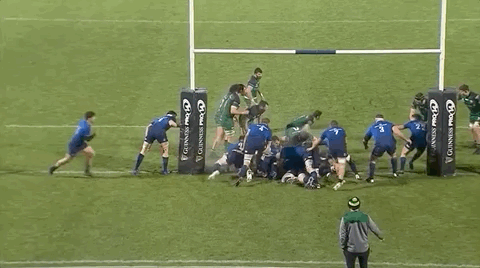“WE’RE PLAYING LIKE absolute giants though, in fairness.”
So said Connacht scrum-half Caolin Blade when referee Chris Busby queried the number of stoppages for injured players in the 65th minute of the westerners’ upset victory against Leinster last Saturday in Dublin.
It was difficult for Busby or anyone else to disagree with Blade, who had taken over as Connacht captain at that stage.
Andy Friend’s men were 18-point underdogs but delivered on an aggressive and intelligent game plan to rock the Guinness Pro14 champions and end their 26-game winning streak in the competition.
With Leinster lacking cohesion partly due to injuries and with inexperience in their backfield, Connacht pulled off an entirely deserved bonus-point victory that featured many superb individual performances.
Smothering defence
Connacht’s win was founded on an exceptional defensive performance that saw them score two intercept tries through Jack Carty and Tom Daly.
Defence coach Peter Wilkins’ men completed 183 tackles to Leinster’s 132. Connacht missed 39 tackle attempts for an overall completion rate of 85% but those misses partly illustrate how aggressive they were with their linespeed, accepting that they would occasionally slip off tackles as looked to prevent Leinster from passing into wide channels, and backing hard-working team-mates to cover any misses.
Connacht’s busiest tacklers:
20 – Quinn Roux
19 – Conor Oliver
16 – Denis Buckley
14 – Gavin Thornbury
13 – Sammy Arnold
12 – Tom Daly
Connacht’s intercept tries were the signature moments of their defensive showing and illustrated just how aggressive they were willing to be at times.
Carty’s ninth-minute score comes just after Connacht have knocked the ball on, but their work-rate to click into defence mode gives him the platform to make a read and pick off Leinster.
As Ryan Baird [white above] looks to move the ball into space following a knock-on by Dominic Robertson-McCoy, we can see Connacht scrum-half Blade [red] working hard in behind the frontline to cover out to the left, where the obvious danger lies.
The turnover situation sees Leinster scrum-half Luke McGrath [white below] making a carry as Blade continues to work out towards the left edge.
The rest of the Connacht defence has also reacted well to the turnover and we can see below that Eoghan and Sean Masterson [yellow] are set up as the two defenders closest to the ruck, while Carty knows he has Blade arriving outside him, with wing Alex Wootton also in the line on his left.
All of that work around Carty arms him with assurance that Connacht are in good shape defensively and he identifies that Leinster lock Ross Molony [white above] is going to step in to pass with McGrath on the ground after carrying.
With the second row always likely to have a longer delivery time with his pass, Carty backs himself to shoot up between Devin Toner and Rory O’Loughlin to make the intercept.
Carty’s timing is superb as he gathers in Molony’s pass and shows good pace to finish from inside his own half, handing the Connacht defence a massive early win and giving his team a major confidence lift after their fine start.
We see another example of Connacht’s aggression in the instance below as the outstanding Daly forces a Leinster error that allows the visitors to strike for Wootton’s crucial try from the ensuing scrum.
Leinster had uncharacteristic struggles exiting from their 22 in the opening half of the game and this is one such instance as they look to pass the ball wide but are shut down by Connacht’s oppressive linespeed.
John Porch [red below] gets high on the right edge of the defence to cut down the passing options and Daly [yellow] aggressively continues to come forward on the inside to force the knock-on from Liam Turner.
We can see above that Connacht leave plenty of space wide on their right and in behind the frontline – similar to the Springboks and other teams – something they were happy to do as they cut down Leinster’s decision-making time.
The reverse angle here also shows that Connacht’s backfield defenders are working to fill space behind having initially lined up to cover a clearing box kick down Leinster’s right-hand side.
It’s obviously a huge turnover for Connacht in this area of the pitch and allows them to score for a remarkable 25-5 lead at the break.
The passage that precedes this turnover is worth looking at closely as it allows us to appreciate another key aspect of Connacht’s game plan: their kicking strategy.
Friend’s men have focused heavily on ‘saving their fuel’ this season, meaning they’re not trying to run the ball out of their own half unless it is clearly on to do so.
Instead, they’re using their kicking game to make territorial gains and, in doing so, retaining energy for when the opposition attempt to run back out or for the ensuing attacking lineout if the opposition kick clear to touch.
This is a good example as Connacht start with a lineout 30 metres from their own tryline and kick through Carty on first phase – something they did on several occasions in this game.
The play is a simple one from Connacht but they achieve their aim of ‘finding grass’ and have Leinster tracking back to gather the ball.
Off a five-man lineout, Sean Masterson and Conor Oliver [white below] run decoy lines ahead of Caolin Blade’s pass in an effort to buy Carty more time to get his kick away.
In the meantime, blindside wing Alex Wootton plays an important role.
The left wing [yellow below] starts tucked in beside Carty but shifts back towards the left touchline in a bid to draw Leinster right wing Andrew Smith [red below] with him.
The ploy works as Connacht would have hoped for as the lineout unfolds, with Smith reacting to Wootton’s movement by closing up towards the touchline.
That movement clearly helps to open more space for Carty’s kick and leaves Smith having to turn and track back.
Meanwhile, fullback Max O’Reilly [white below] has started over on the left-hand side of Leinster’s backfield, worrying about the possible kick space there, and now has to work across to his right.
Carty’s surprise kick back against the grain finds grass and rolls on into the Leinster 22 as Connacht’s forwards are given the happy task of chasing upfield from the lineout.
O’Reilly retreats to scoop up the ball and is faced with a kick/run decision, opting to hold onto the ball despite having every Leinster player aside from Smith ahead of him.
The Leinster fullback is swallowed up by Quinn Roux and Dominic Robertson-McCoy in the tackle. It appears that Roux’s tackle slips onto O’Reilly’s neck but there is no penalty in this instance and already Connacht will feel they have made the kick successful.
Happily for Friend’s side, Leinster opt to attempt to run the ball out a second time and having ‘saved their fuel,’ Connacht are aggressive in forcing the knock-on we saw earlier.
Kicking weapon
Connacht kicked 30 times in play in this game, which is above their usual average – an average that had already risen since last season.
Leinster’s inexperienced back three featuring debutants O’Reilly and Smith clearly seems to have been a focus for Connacht as they regularly found grass in the home side’s half, with Carty’s excellent kicking performance leading the way.
Caolin Blade kicked five times from scrum-half, while Porch, Sammy Arnold, and Wootton also contributed kicks, but this is Carty’s domain.
Friend has encouraged Connacht’s players to identify their unique ‘weapons’ and fully exploit those strengths. Carty’s weapon is tactical kicking and he has continued to push that side of his game.
Below, we see an illustration of Carty’s 18 kicks in play against Leinster, plotting where he kicked from and the outcome of each of his kicks. All kicks from both halves of the game are plotted with Connacht playing from left to right.
We can see that Carty found grass in the Leinster half on seven occasions, with the ball often bouncing well beyond the landing points indicated by the arrowheads above. That is a very successful return and underlines how he found plenty of space in the backfield.
Carty’s one contestable kick of the game [black above] produced a Leinster knock-on as he cleverly targeted replacement Hugh O’Sullivan, normally a scrum-half but left in the backfield amidst Leinster’s injury problems.
Carty had three exiting kicks directly into touch from inside his own 22 but we can see that he also rolled the ball into touch from four different kicks in or just outside the Leinster half, albeit one of them was mishit.
Carty’s willingness to find touch in the Leinster half also underlined how Connacht had focused on their lineout defence as a key part of their game plan.
Leinster have had lineout issues in recent times that they will surely be working hard to resolve and in this instance, the pressure from Sean Masterson in the air and a relatively low throw from James Tracy result in a very scrappy win by Devin Toner that is then knocked-on by Luke McGrath in the scramble.
Quinn Roux had a clean steal of a botched Leinster lineout in the first half, Leo Cullen’s side threw clean over the back of another in the second half, and Connacht forced another turnover after a scrappy Leinster win under pressure in the second half, as well as disrupting on one other occasion.
In total, only 10 of Leinster’s 15 lineouts were won cleanly on what was a very good day for Connacht forwards coach Jimmy Duffy and his players.
Connacht’s combination of a strong kicking game and defensive strength ensured Leinster struggled to get a foothold in the game in the first half.
Indeed, Leo Cullen’s side had just 14 seconds of possession inside the Connacht 22 before the break, with their only two visits coming from Scott Penny’s sudden try on turnover and then Ryan Baird’s excellent linebreak, which ended with a Connacht turnover penalty earned by Eoghan Masterson.
Turnover threat
Leinster are generally very effective in denying the opposition turnovers, averaging around five concessions per game in the Pro14 this season, but Connacht won nine defensive turnovers at the RDS as they brought a destructive edge.
They were aggressive and accurate at the breakdown in their bid to prevent Leinster from getting attacking flow.
The relentless Conor Oliver was the chief pest for Leinster at the breakdown as he won two very valuable turnover penalties in a hard-jackaling performance.
The Skerries man’s first turnover penalty indirectly allowed Connacht into position to earn three points for a 15-5 lead, while his second penalty win was directly responsible for Carty extending that advantage to 18-5.
Again, it stems from Connacht’s work-rate on kick chase.
As we see above, fullback Porch fields a poor kick from Leinster – who badly missed a recognised out-half after Johnny Sexton’s first-half injury – and the Australian responds in kind to find grass in the Leinster 22.
Jimmy O’Brien, who has just kicked to Porch, retreats to gather the ball and again attempts to run it out, only for Porch to cling onto his left ankle. O’Brien offloads to O’Reilly but Porch is straight back on his feet to tackle his opposite number…
… allowing Oliver to follow up and jackal, earning the penalty with strong assistance from lock Gavin Thornbury, who provides stability and draws some of Leinster’s clearout focus away from Oliver.
Oliver starts well ahead of Porch in this instance and is actually one of several players pointing out the kick space to the fullback before waiting to be brought onside by Porch, then follows up doggedly with Thornbury to take the turnover opportunity.
While he also carried eight times for 21 metres and one defender beaten, Oliver’s impact defensively was very impressive for Connacht.
Below, we see an illustration of his defensive contributions across the 80 minutes, including tackles, turnovers, and other jackal attempts. Again Connacht are playing from left to right in this depiction.
Oliver made a big impact with many of his 19 tackles, only missing two later in the game as he and Connacht understandably fatigued.
Beyond his two turnovers, Oliver had seven further genuine attempts at stealing Leinster’s possession as he was a nuisance for them at the breakdown. He very well could have had another penalty win just outside the Connacht 22 in the 55th minute, although the openside would have been frustrated with a late penalty concession for failing to release from the tackle before looking to poach.
Lightning strikes
Of course, Connacht didn’t just kick and tackle against Leinster.
They scored four tries to secure the bonus point, with two of them underlining this team’s ability to strike like lightning after ‘saving fuel’ at other times.
Carty’s second try stemmed from a clever narrow attack through hooker Shane Delahunt and Blade.
Attack coach Nigel Carolan asks his players to scan for opportunities in different zones of the defence, whether that be in midfield, out wide or in behind the defence, while the area through the ruck or just on the edge of it is another – as exploited here.
It’s excellent decision-making from Delahunt here as he identifies the opportunity presented by Leinster’s defence.
The shot below gives us a good illustration of the mix-up from Leinster.
Penny [white below] folds around the corner from right to left in defence and as Devin Toner outside him calls for slightly more width, Penny clearly wants Jimmy O’Brien [red] to follow him in folding into the left ‘pillar’ position at the edge of the ruck.
However, we can see below that O’Brien has held in the right pillar position and is signalling for Penny to close back into the left pillar slot.
With the Leinster defenders on different wavelengths, Connacht have a very brief window of opportunity and Delahunt takes it without hesitation.
He bursts forward and despite Penny and O’Brien reacting to tackle him, Delahunt is able to pop the offload away to Blade, who reacts instantly to the hooker’s decision.
As we see below, Carty shows good energy and pace to get upfield in support of his scrum-half, taking the inside pass before he’s tackled five metres out.
While Leinster do manage to slow the ball down at the next ruck, Connacht finish their try three phases later as Carty runs a hard line off Blade more akin to a back row forward or centre, forcing his way over for his second score.
Connacht’s third try just before the break demonstrates some of the set-piece smarts they have had under attack specialist Carolan.
It comes from the five-metre scrum they’re awarded after the Leinster knock-on we discussed earlier and Connacht use a typically clever play.
Carty and Porch [white below] start in a stack directly behind the scrum, meaning they are attacking threats on both sides.
As the Connacht forwards provide a superb clean scrum platform, Leinster scrum-half Luke McGrath [red below] is faced with uncertainty as he worries about Carty and Porch breaking to their right.
That’s exactly what Carty and Porch do, darting to the right just as Blade moves to scoop the ball off the ground.
As a result, McGrath [red below] is initially lured into shifting across to the left side of Leinster’s scrum.
Meanwhile, Connacht centres Daly and Arnold [yellow below] are starting to run direct lines to the left of the scrum as if they’re about to receive a flat pass from Blade.
The Connacht midfielders are keen to draw the Leinster backline defenders’ eyes onto them, worrying about a hard carry on first phase.
Every detail is designed to draw attention away from Blade himself, who suddenly scoops and darts to his left.
Blade takes his cue from McGrath briefly shifting to follow Carty and Porch’s movement, with the Connacht scrum-half even quickly glancing to his right to further sell that decoy.
Instead, Blade scoops the ball and shows his acceleration to burst forward into the space Connacht have manufactured. With the scrum in good working order, Connacht’s back row have to stay down and Blade accentuates the challenge for Penny by darting outside referee Chris Busby.
To McGrath’s credit, he recovers to land a strong tackle on Blade, combining with Penny and Rory O’Loughlin to just about do enough to prevent the Connacht scrum-half from scoring on first phase.
But Connacht have already narrowed Leinster as the home side look to recover and two phases later, three passes from Blade, Carty and Daly send Wootton over to score.
Carty’s conversion sends Connacht 25-5 in front at the break and the mountain proves insurmountable for Leinster in the second half.
With Carty adding a further penalty and Daly sealing the deal with Connacht’s second intercept try, the bonus-point score, they could celebrate their first win in Dublin since 2002.
